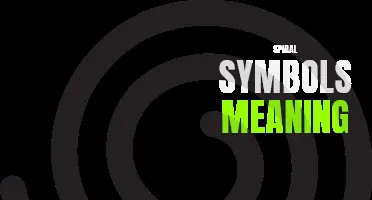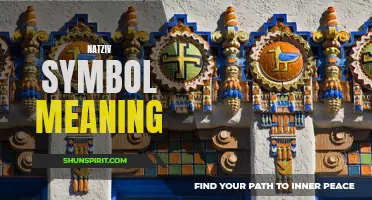
The berserker symbol is an ancient and captivating emblem that holds great significance in Norse mythology and Viking culture. Representing the unleashed fury and brutality of the fearless warriors known as berserkers, this symbol embodies the primal power and untamed strength that they were believed to possess. As formidable foes on the battlefield, the berserkers would go into a trance-like state, tapping into their inner rage and transforming into unstoppable forces of destruction. The berserker symbol captures this intense and relentless energy, making it a compelling emblem that embodies the raw power and ferocity of these legendary warriors. Join us on a journey to explore the depths of the berserker symbol and unravel its rich meaning and history.
What You'll Learn
- What is the origin of the berserker symbol and what does it represent in Norse mythology?
- How has the meaning and symbolism of the berserker symbol evolved over time?
- What are some common interpretations and associations with the berserker symbol in modern culture?
- Are there variations or different versions of the berserker symbol, and do they have different meanings?
- How does the berserker symbol tie into the broader concept of battle and warrior culture in Norse mythology?

What is the origin of the berserker symbol and what does it represent in Norse mythology?
The berserker symbol is one of the most iconic symbols in Norse mythology. Known for their ferociousness and battle prowess, the berserkers were legendary warriors who fought with an uncontrollable rage and a seemingly supernatural strength. The berserker symbol represents this untamed aggression and the transformative power that these warriors possessed.
The origin of the berserker symbol can be traced back to ancient Norse traditions. The word "berserker" is derived from the Old Norse term "berserkir," which roughly translates to "bear shirts" or "bear skins." This name was given to the warriors because they often wore bearskin cloaks or other animal pelts as part of their battle attire. The symbol itself is believed to have originated from the use of these animal skins as a method of channeling the spirit of the bear, which was associated with strength, aggression, and protection.
In Norse mythology, the berserkers were believed to be under the influence of Odin, the chief god of the Norse pantheon. It was believed that Odin would choose certain warriors to become berserkers and grant them his powers. When in battle, these warriors would enter a state of "berserkergang," which can be translated as a "berserker rage" or a "fury state." In this state, the warriors would lose control of themselves and become consumed by a wild and uncontrollable fury, turning them into almost unstoppable forces on the battlefield.
The berserker symbol is often depicted as a stylized representation of a bear or a bear's head. The bear symbolizes the primal and instinctive power of the berserkers, as well as their connection to the wild and untamed forces of nature. The symbol can be seen on shields, helmets, and other personal belongings of the berserkers, as a way to invoke the strength and protection of the bear spirit.
The berserker symbol is also associated with courage, fearlessness, and the willingness to embrace one's inner power. It is a symbol of defiance, as the berserkers were often seen as rebels and outlaws who lived outside the boundaries of society. The symbol represents the rejection of societal norms and the embrace of a more primal and authentic way of being.
In modern times, the berserker symbol has become a popular motif in various forms of media, including movies, books, and video games. It is often depicted as a badge of honor for warriors who embody the spirit of the berserkers and who are unafraid to unleash their inner power and rage.
In conclusion, the berserker symbol represents the untamed aggression and transformative power of the legendary warriors known as berserkers in Norse mythology. It originated from the use of animal skins, particularly bear skins, as a means of channeling the spirit of the bear. The symbol represents the primal and instinctive power of the berserkers, as well as their connection to the wild forces of nature. It is a symbol of courage, fearlessness, and the rejection of societal norms. Today, the berserker symbol continues to be celebrated in various forms of media as a representation of unbridled strength and fury.
The Hidden Meanings Behind Tupperware Symbols Revealed
You may want to see also

How has the meaning and symbolism of the berserker symbol evolved over time?
The berserker symbol is an ancient symbol that has held various meanings and symbolism throughout history. From its roots in Norse mythology to its modern-day representations, the symbol has evolved to reflect different beliefs and cultural interpretations.
In Norse mythology, the berserker symbol was associated with the legendary berserkers, a group of Norse warriors known for their fierce battle rage. These warriors were said to channel the spirit of the bear, symbolized by the berserker symbol, to gain strength and fearlessness in battle. The bear was seen as a powerful and ferocious animal, and the symbol represented the warrior's ability to tap into this primal energy.
Over time, the meaning and symbolism of the berserker symbol expanded beyond its association with Norse mythology. In the Viking Age, the symbol came to be associated with strength, courage, and warrior spirit. Vikings would often wear the symbol as a talisman of protection and as a way to communicate their prowess in battle.
As Christianity spread throughout Scandinavia, the berserker symbol took on a new meaning. It became associated with paganism and was seen as a symbol of opposition to the Christian faith. Berserkers were viewed as wild and uncontrollable, representing a threat to the Christian order. The symbol was often demonized and associated with evil or madness.
In modern times, the berserker symbol has been adopted by various subcultures and groups. In some contemporary Norse neopagan traditions, the symbol is seen as a representation of the warrior spirit and connection to nature. It is used as a symbol of personal strength and power.
In popular culture, the berserker symbol is often used to represent a state of intense rage or fury. It is commonly associated with violent and aggressive behavior, as depicted in movies, video games, and literature. The symbol has become a recognizable icon for the concept of "going berserk" or losing control.
In recent years, there has been a renewed interest in Norse mythology and Viking culture, leading to a resurgence in the popularity of the berserker symbol. It is now commonly used in various forms of artwork, tattoos, and fashion, often as a symbol of strength, courage, and resilience.
Overall, the meaning and symbolism of the berserker symbol have changed and evolved over time. From its origins in Norse mythology to its present-day representations, the symbol has come to represent different ideas and beliefs in different cultures. Whether seen as a representation of warrior spirit, a symbol of opposition, or a character of uncontrollable rage, the berserker symbol continues to captivate and intrigue people today.
Understanding HP Printer Symbols: What Do They Mean?
You may want to see also

What are some common interpretations and associations with the berserker symbol in modern culture?
The berserker symbol is a powerful and intriguing symbol that has captured the imaginations of many people in modern culture. This symbol is often associated with strength, ferocity, and a fierce warrior spirit. It has been used in various forms of media, such as literature, movies, and video games, to represent characters who possess extraordinary powers and abilities.
One common interpretation of the berserker symbol is that it represents the concept of being uncontrollable or irrational in battle. The berserkers were ancient Norse warriors who were known for their wild and savage fighting style. They would enter a state of frenzy or trance-like state, often attributed to the consumption of hallucinogenic substances, which would make them impervious to pain and fear. This interpretation of the berserker symbol highlights the primal and untamed nature of the human spirit and the ability to tap into seemingly limitless powers during times of conflict.
In popular culture, the berserker symbol has been depicted in various forms, such as tattoos, clothing, and artwork. It is often portrayed as a stylized image of a menacing warrior with bulging muscles, wild hair, and a feral expression. These depictions convey a sense of raw power and aggression, emphasizing the warrior spirit that the symbol represents.
In literature, the berserker symbol has been incorporated into fantasy and mythology-based novels. These stories often feature characters who possess berserker-like abilities, such as enhanced strength, speed, and endurance. These characters are usually portrayed as formidable warriors who are feared and respected by their enemies. The berserker symbol in these stories serves as a representation of the character's untamed and indomitable spirit.
In movies and television shows, the berserker symbol has been used to represent characters who possess extraordinary physical abilities. These characters often exhibit superhuman strength, reflexes, and durability, making them formidable opponents in battle. The berserker symbol in these visual mediums serves as a visual shorthand to convey the character's formidable nature and fighting prowess.
Video games have also incorporated the berserker symbol into their gameplay mechanics and character designs. In many role-playing games, players can choose to play as a berserker character class, which is often associated with high damage output and a focus on close combat. These characters typically have a berserker symbol emblazoned on their armor or weapons, indicating their affinity for frenzied and aggressive combat styles.
Overall, the berserker symbol holds a significant place in modern culture as a representation of ferocity, strength, and untamed power. Its association with fierce warriors and extraordinary abilities has made it an iconic symbol that continues to captivate and inspire individuals across various forms of media. Whether displayed as a tattoo, worn as clothing, or depicted in artwork, the berserker symbol remains a potent reminder of the primal and indomitable spirit that lies within us all.
Decoding the Dark: Unraveling the Meaning Behind Bad Omens Band Symbols
You may want to see also

Are there variations or different versions of the berserker symbol, and do they have different meanings?
Berserkers are ancient Norse warriors known for their intense battle rage. They were legendary fighters who fought with unmatched fury and fearlessness, often going into a trance-like state in battle. The symbol associated with berserkers is the bear, and it represents their animalistic and ferocious nature. However, there are variations of the symbol, and they can carry different meanings.
The most common symbol associated with berserkers is the bear paw. This symbol depicts the claw marks of a bear and represents the power and strength of the berserker. It is often seen as a representation of their connection to nature and their ability to tap into the primal instincts of the bear. The bear paw symbolizes the wild and untamed spirit of the berserker.
Another variation of the berserker symbol is the bear head. This symbol represents the fierce and relentless nature of the berserker, as well as their connection to the bear. It signifies their ability to channel the power and ferocity of the bear in battle. The bear head symbol is often associated with leadership and strength, as the berserker is seen as the alpha of the pack.
There are also variations of the berserker symbol that incorporate other elements, such as weapons or armor. These symbols represent the warrior aspect of the berserker and emphasize their skill and prowess in battle. They depict the berserker as a fearsome and unstoppable force on the battlefield.
While the variations of the berserker symbol may have different designs, they all carry similar meanings. They represent the untamed and animalistic nature of the berserker, as well as their connection to the bear. They symbolize their intense battle rage and their ability to tap into a trance-like state in battle. Overall, the various versions of the berserker symbol serve to honor and commemorate these legendary warriors and their unique fighting style.
In conclusion, there are variations of the berserker symbol, including the bear paw, bear head, and symbols incorporating weapons or armor. These variations all represent the fierce and untamed nature of the berserker, as well as their connection to the bear. They symbolize their intense battle rage and their ability to tap into a trance-like state in battle. Despite the different designs, the variations of the berserker symbol carry similar meanings and serve to pay homage to these legendary Norse warriors.
The Hidden Meanings Behind the Arrowhead Symbol
You may want to see also

How does the berserker symbol tie into the broader concept of battle and warrior culture in Norse mythology?
The berserker symbol is an iconic emblem in Norse mythology, representing the fierce warriors known as berserkers. These warriors were known for their exceptional skills in battle and their ability to tap into a state of uncontrollable rage during combat. The berserker symbol plays a significant role in understanding the broader concept of battle and warrior culture in Norse mythology.
In Norse mythology, battle and warfare were prominent themes. The Norse gods themselves were often depicted as warriors and were known to engage in epic battles against various entities, such as giants and monsters. It was a world where strength, valor, and combat prowess were highly valued.
The berserkers, however, stood out among the warriors of Norse mythology. They were revered for their incredible courage and ferocity in battle. The name "berserker" comes from the Old Norse words "ber-serkr," which translates to "bear-shirted," possibly indicating that they wore bear pelts or skins during battle to enhance their fierce persona.
The berserker symbol, often depicted as a stylized bear or a warrior in a berserker trance, signifies the wild and untamed nature of these warriors. It represents their ability to tap into a supernatural state of frenzy during battle, granting them exceptional strength, speed, and endurance. It is believed that this state was induced through rituals, such as consuming hallucinogenic substances or through intense spiritual and mental preparation.
The berserker symbol also mirrors the larger warrior culture in Norse mythology. Battle was not just a means of survival or conquest but held a deeper significance in Norse society. Warriors were honored and revered for their bravery, and tales of their heroic deeds were immortalized through poems and sagas. They were considered an essential part of the social fabric, and their ability to protect and defend their people was highly esteemed.
The berserker symbol, with its association with the untamed power of nature, also reflects the deep connection between the Norse warriors and the natural world. In Norse mythology, nature was seen as wild and unpredictable, just like the berserkers in battle. The symbol serves as a reminder of the inseparable bond between warriors and the natural forces they sought to harness and embody.
In conclusion, the berserker symbol is an integral part of the broader concept of battle and warrior culture in Norse mythology. It represents the exceptional skills and ferocity of the berserkers in battle, as well as their ability to tap into a supernatural state of frenzy. The symbol also reflects the larger warrior culture in Norse society and the deep connection between warriors and the untamed forces of nature. By understanding the significance of the berserker symbol, we gain a deeper understanding of the role of warriors in Norse mythology and their place in the Norse worldview.
Understanding the Symbolism Behind the Jainism Symbol
You may want to see also
Frequently asked questions
The berserker symbol is associated with an ancient Norse warrior known as the berserker. The symbol represents a state of wild fury and madness that the berserker would enter into during battle. It is seen as a symbol of strength, fearlessness, and the ability to overcome all obstacles.
While the berserker symbol may not be as commonly recognized or used today, it still holds significance for those who identify with Norse mythology and Viking culture. Many people who study or appreciate Norse history and mythology may choose to incorporate the berserker symbol into their artwork, tattoos, or personal beliefs.
There is no strict rule or requirement to use the berserker symbol. However, it is important to approach and use any cultural or historical symbol with respect and understanding. It is recommended to research and learn about the history and meaning behind the symbol before incorporating it into any personal or public displays.
The berserker symbol is often associated with other Viking and Norse symbols, such as the Valknut (a symbol of Odin) and the Mjolnir (Thor's hammer). These symbols often represent bravery, protection, and strength, which align with the themes and characteristics of the berserker.
To learn more about the berserker symbol, one can explore books and resources on Norse mythology, Viking history, and ancient Norse warrior traditions. Online research and academic studies can also provide further insights into the origins and meanings of the berserker symbol.



















